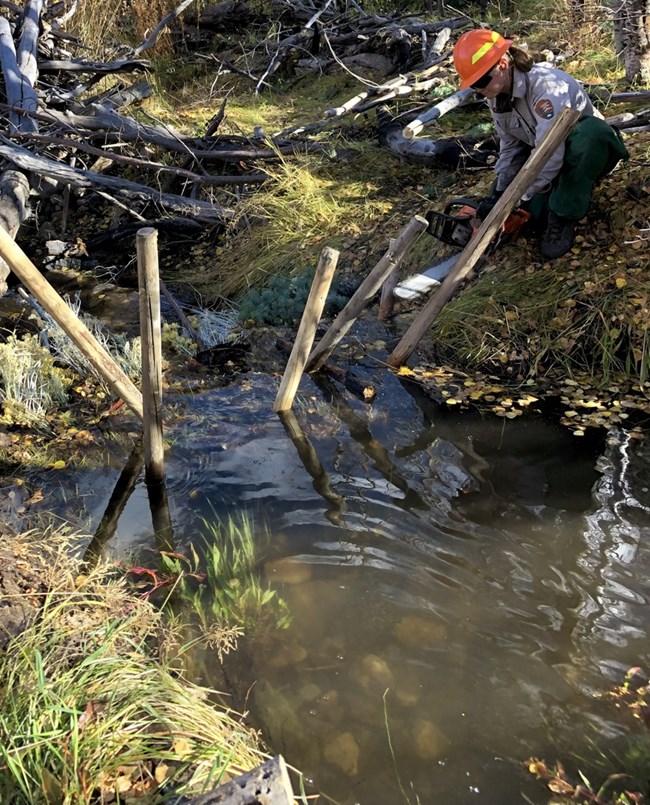Part of a series of articles titled The Midden - Great Basin National Park: Vol. 23, No. 2, Winter 2023.
Article
Leave it to Beaver… Dam Analogs
This article was originally published in The Midden – Great Basin National Park: Vol. 23, No. 2, Winter 2023.

NPS Photo/Emily Luberto
Beaver dam analogs (BDAs) are an innovative way Great Basin National Park can restore vital habitat in and around streams. BDAs are inspired by the many benefits beaver dams have on riparian systems and mimic the natural processes beavers help maintain in healthy streams. Both BDAs and beaver dams back up small stretches of moving water in stream channels, slowing the flow of water and raising water levels. This partial and temporary pooling of water creates habitat for fish, maintains connection between the water table and wetland vegetation, increases complexity in the stream channel, and catches sediment.
Although BDAs are human-made structures, they are built with natural materials found onsite like willow and aspen, just as North American beaver would use. For several years the park and Nevada Department of Wildlife have installed BDAs and post-assisted log structures to help mitigate negative impacts from recent fires.
Building a BDA requires teamwork, a little creativity, and a willingness to get your hands dirty. The first step in creating a BDA is to choose a site that has the necessary materials. Logs, brushy vegetation, and a plentiful supply of mud are the foundation of strong and effective structures. Sites are also chosen based on site conditions. Some locations along the stream are better suited based on biologic, physical, or hydrologic conditions.
Once a site is chosen and necessary materials are gathered, large woody debris, like sticks and logs, are laid down in the stream channel side, parallel to the flow of water. The upstream ends of the woody debris create a uniform line across the stream from one bank to the other. This line is then covered and packed in with silty clay mud to create a slightly raised mound that stretches across the stream, perpendicular to the flow of water.
Next, a layer of brushy vegetation, lined up in the same fashion bank to bank, is laid down just slightly downstream from the starting point and covered with another layer of mud. This stepwise layering of wood and brushy vegetation with mud packed into each layer continues until the BDA reaches the appropriate height, often equal with the stream bank. Ideally, water will flow slowly and evenly over the top of this now raised mound of mud and vegetation. For added support, the team finishes up by driving untreated wooden posts into the structure using a hydraulic post pounder, one tool humans have that beavers do not.

NPS Photo/Emily Luberto
Moving water is a powerful force responsible for many geologic formations and landscape changes. Over time, fast moving water can cut through land, creating a narrow channel where water can flow faster and deeper and lead to channel incision. When a stream channel is incised, the water from the stream is lower than the land surrounding it. Incision in post-fire areas like Strawberry Creek in Great Basin National Park can be significant, as much as 12 feet in some places.
BDAs can help alleviate stream channel incision. Slowing water down reduces its cutting force and allows for the formation of new stream banks where riparian vegetation can reestablish. Although repairing incised banks is not as immediate of an effect as creating backwaters, the benefits can be seen over time with structure maintenance and monitoring.
In some places, stream systems may need restoration but lack the materials to build a BDA or meet conditions to successfully build one. In these cases, a structure called a post-assisted log structure, or PALS, can be installed. PALS are piles of large woody debris like logs, stumps, and branches that are arranged to slow the movement of water, increase instream complexity, and limit incision. PALS are messier and less dense, as part of their purpose is to add woody debris to wood-starved streams and catch debris being transported downstream. Just as BDAs mimic the benefit of beaver dams, PALS are built to sustain processes produced by natural log jams.
Another alternative to BDAs is actual beaver dams. BDAs attempt to mimic dams made by beavers, but these ecosystem engineers are the best alternative for healthy stream systems. Beavers are experts at slowing water and creating habitat for fish and riparian vegetation. And unlike manmade BDAs, beavers are out there constantly maintaining and improving their dams.
Installing BDAs and PALS is just one way the natural resource team at Great Basin National Park is taking steps to restore and protect diverse riparian habitat. Beaver dam analogs and post-assisted log structures are low-tech, cost-effective stream restoration tools that can restore and maintain fish and wildlife habitat, improve connectivity and complexity, and support biodiversity.
Last updated: December 5, 2023
